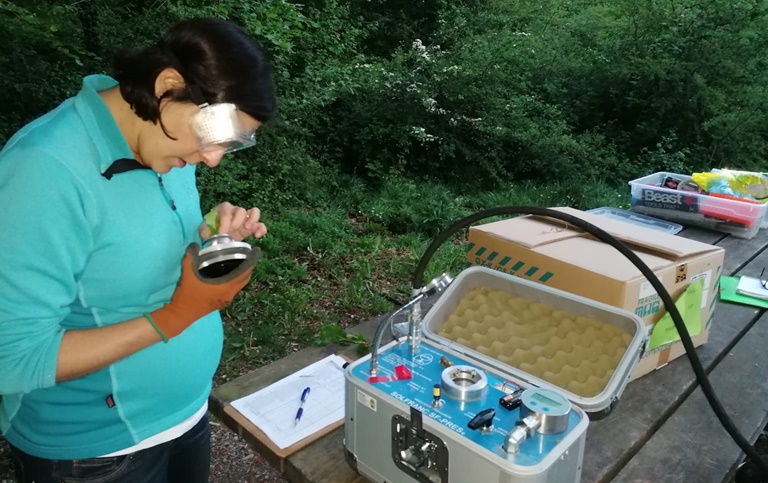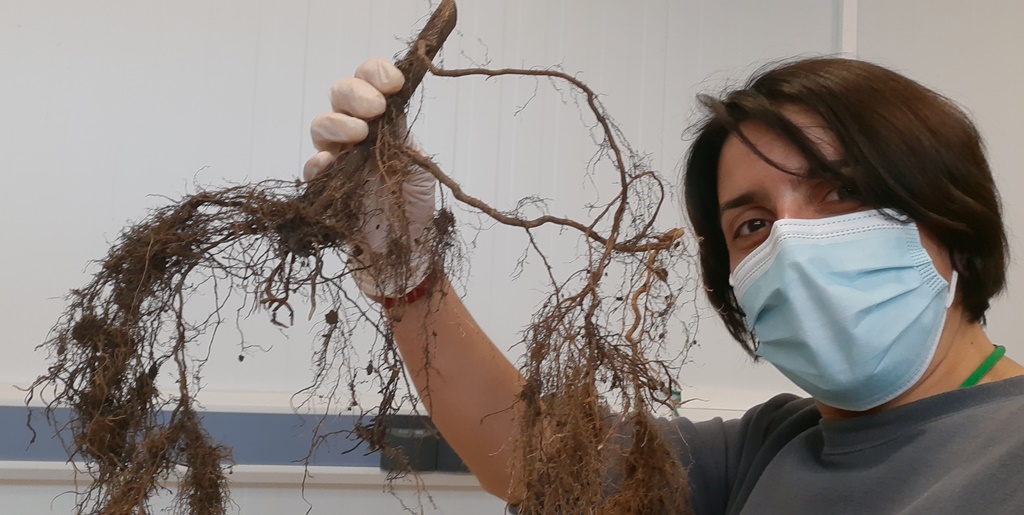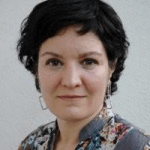Teresa Gimeno and the constant question
Prudence and discretion are adjectives that define researcher Teresa Gimeno as aptly as determination and firmness. Its proximity in forms facilitates a friendly conversation, always filtered by scientific modesty and sprinkled with declarations of principles, doubts and certainties resulting from a diverse international career. She can suddenly interrupt her story, smile and show an infectious complicity, thanks to an approachable and sometimes unpredictable sense of humour. With this background, the decisions and opportunities of her scientific career have taken her halfway around the world. "My first vocation was to learn, to find out how some discoveries were made and, from there, I became involved in a career in science" .
"My first vocation was to learn, to know how some discoveries were made and, from there, I chose a career in science"
Her research about plant ecophysiology has grown at centres such as the Hawkesbury Institute for Environment from the Western Sydney University (Australia), the Institut National de la Recherche Agronomique INRAe, (Bordeaux, France), the Basque Center for Climate Change BC3, (Leioa, Basque Country) and currently in the CREAF (Barcelona), where she recently held a research position as part of the Severo Ochoa Excellence programme. Her scientific curiosity and her interest in solving questions began at the National Museum of Natural Sciences CSIC in Madrid, where she wrote her doctoral thesis with Fernando Valladares and Adrián Escudero. That meant entering an environment that she remembers as having immense possibilities: "there were options, you could choose which questions you wanted to answer".
Today she admits: “I am still a sponge like when I started, if I continue in science it is because I have the opportunity to learn every day. When you start in the scientific career you are in the audience and you do not feel confident or able to put yourself on the other side and ask new questions, studies, guide lines, etc. That came later and there are still days when I think it hasn't arrived yet".

One of the privileges of her journey is to have come across someone who taught her to think differently. This was one of the lessons she learned from researcher Lisa Wingate -director of the laboratory at the INRAe, with which she is still associated - and from whom she learned to take alternative positions to the most common ones. “With Lisa Wingate I learned to empty my mind and ask new questions. To raise questions that had not been thought of before, that did not perpetuate the practice of applying to juniper a question already resolved for pine... which is the direction in which I had headed. My work with her marks a before and after in my way of seeing a scientific career, without a doubt it influenced me a lot”. Teresa Gimeno also assimilated the importance of disseminating, of projecting herself externally as a scientist with a solid career and of seeking a motivating professional environment. “Until then I had focused my career exclusively on productivity: ask a question, publish articles, get funding and so on in a cycle. Lisa Wingate made me think of things I hadn't thought of before: I started to see myself as someone who has a seat at the table, who is part of the performance."
"Thinking differently seems to me the biggest challenge. It is difficult to hypothesize by oneself, to think how to solve a complex problem independently to come up with creative solutions"
Thinking out of the box
The value and extraordinary of learning to think differently makes even more sense for a scientist who takes nothing for granted. "To me it's the biggest challenge", she admits. "It is difficult to hypothesise for oneself, to think how to solve a complex problem independently in order to come up with creative solutions" And, once again, caution: "I, of course, have not yet found the recipe. Going beyond the obvious solution and looking for alternatives is very complex, both for the big question that may lie behind a scientific article or project, and for day-to-day issues such as organising a field campaign.
In her study of plant ecophysiology, she analyses how vegetation will withstand the various scenarios of global change: new land uses, different CO2 concentrations in the atmosphere and changes in the ratio of nutrient availability due to human activity. "When we finish a study we usually have more questions than when we started, because we discover patterns and answers that we are not able to explain. When we look into previous work, we find even more questions and that motivates me a lot: it's like looking for the missing piece of the puzzle", she says passionately. "It's very satisfying to think that I've contributed a little bit to generating knowledge, because it's a giant puzzle. And sometimes you manage to connect two questions that seemed independent, and that's what's really exciting.

If asked how her research contributes to society, she explains she studies how vegetation functions in its essence in a context of global change. Something that qualifies as "the cornerstone of the functioning of ecosystems", which will allow us to make predictions about how they will respond, how to preserve them and how to obtain raw materials in the face of the warming we are experiencing". She does research to answer, for example, "how much carbon the vegetation will be able to absorb or emit. The calculations behind the IPCC (Intergovernmental Panel on Climate Change) reports are largely based on parameters obtained by specialists in ecophysiology. The publications I work on are sometimes cited in reports like the IPCC.”
A forest as a testing ground
"Often colleagues are more decisive than the person running the lab. It is useful to share everything from installing sensors, to programming in a particular language, to dealing with stressful situations, to communicating, to answering a scientific journal review.... things for which there is no manual!"
At the Hawkesbury Institute for Environment of the Western Sydney University she had the immense good fortune of collaborating in what he describes as the “one of the most spectacular and beautiful projects I have ever been involved in”, the Eucalyptus Free Air CO2 Enrichment Experiment. It is still active and simulates a climate change scenario in an entire native forest, specifically eucalyptus, in which it reproduces the atmosphere we will experience on Earth in 2050... "or even in 2040 at this rate", she admits. The forest is sprayed with CO2 to identify how its concentration in the atmosphere increases and the efficiency of water use in the entire ecosystem. "It was 3 very productive and fun years: I learned hydrology, atmospheric circulation, a lot of ecophysiology... I worked side by side with very qualified staff, it was a fantastic experience.
As the forest responds slowly, the initiative has been active since 2012. "In a natural scenario, vegetation will be exposed to CO2 concentration every day and very gradually. The only way we can answer how it will react, how it will be affected by water and nutrient cycles, etc... is through long term projects".
She met Professor David Ellsworth in Australia, another of her professional role models. "I have been very lucky with mentors, supervisors and peers, who are often more decisive than the person in charge of running the lab. It is useful to share everything from installing sensors, to programming in a specific language, to dealing with stressful situations, to communicating, to answering a scientific journal review... things for which there is no manual!

Australia also marks a vital before and after because she met her partner there, an engineer in environmental sciences and forestry, with a clearly technological profile. "He has changed jobs 3 times for me... I don't know any other male partner who has done this for his female partner". Questions and queries drive the life of this young scientist with a friendly disposition, who conveys some very stable certainties.
This action is part of the Severo Ochoa “ULandscape” funded in 2019 by the Agencia Estatal de Investigación of the Spanish Ministry of Science and Innovation to support Research Centres of Excellence.







